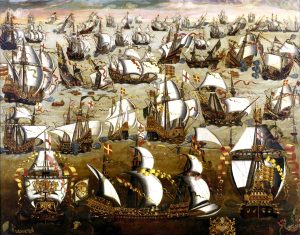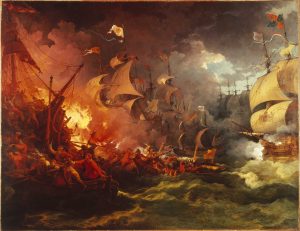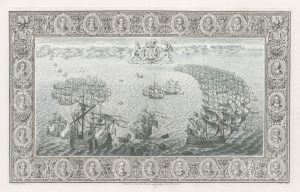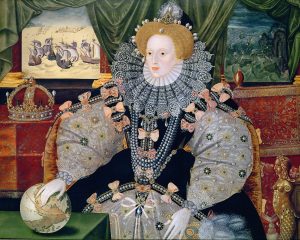13 The Rise of the British Empire by Joshua Lake
1. The Rise of the British Empire: Analysing the cause and consequences of the Spanish Armada (1588)

English Ships and the Spanish Armada, August 1588 Author Unknown, Public Domain
| Curriculum context | VCE Unit 1 Empires, Area of Study 1 (VCAA, 2020) |
| Historical context | The events and the differing religious perspectives of Elizabeth I and Phillip II that caused the Spanish Armada and the tactics implemented and types of ships used by the British Empire to combat the Spanish Armada’s fleet and the consequences of the Spanish Empire’s defeat. |
| Historical thinking concepts | Cause and consequence
Historical interpretations |
| Learning intentions |
Identify and describe the different tactics implemented in the Spanish Armada and how it changed the naval warfare afterwards.
|
Activity
Part A: Understanding the cause of the Spanish Armada
Creating a timeline helps us better understand what caused a major event. Your task is to conduct your own research on the events below and fill out each box to discover how the religious perspectives of Philip II and Elizabeth I ultimately caused the Spanish Armada (1588).

Part B: Evaluating the consequences of the Spanish Armada
After completing Part A, you must upload your timeline on the class Padlet or other digital platform. Then look at the following sources to answer the questions below:
Questions
- What tactics were employed by the British to overcome the size of the Spanish Armada?
- What were the perspectives of the British towards the Spanish Armada?
- How did the other empires perspectives change following the victory of the British Empire?
- How was the perspective of war tactics changed after the Spanish Armada?
- Why was the Spanish Armada a significant stepping stone for the British Empire?
After answering the questions, discuss your responses with the person next to you.
References
Britannica. (2023). Spanish Armada. Britannica. https://www.britannica.com/topic/Armada-Spanish-naval-fleet
McCollum, A., Greenwood, N., Toye, D., Vick, A. Kemp, M. Widener, N. ( n.d.). Catholic Spain, OER Commons. https://oercommons.org/courseware/lesson/87870/overview
VCAA. (2020). VCE Study Design: History 2022-2026. Victorian Curriculum and Assessment Authority. https://www.vcaa.vic.edu.au/curriculum/vce/vce-study-designs/history/Pages/index.aspx
2. The rise of the British Empire: Source analysis

Defeat of the Spanish Armada, 8 August 1588 by Philip James de Loutherbourg, Public Domain
| Curriculum context | VCE Unit 1 Empires Area of Study 1 (VCAA, 2020) |
| Historical context | The source that depicts the formation of the ships shows the different tactics implemented by both sides. The implementation of the tactics that the British Empire used would change naval warfare and view the British Empire as the most dominant Empire in Europe.
The portrait highlights Elizabeth I’s most famous battle victory during her reign (the British Empire’s defeat of the Spanish Armada in 1588). |
| Historical thinking concepts | Use sources as evidence |
| Learning intentions |
Identify and discuss how the Spanish Armada consolidated Elizabeth I’s British Empire as a powerhouse in Europe through their rivalry against the Spanish Empire.
|
Activity
Part A
Analysing artworks, photography, drawings, and maps is a vital skill for you to gain an understanding of past events. Therefore, in groups of 4, your task is to analyse the sources below and answer the guiding questions. You will also post your responses on the class Padlet other digital platform . Afterwards, we will discuss your findings as a class.
Source 1: Drake takes De Valdess Galleon – The Lord Admiral Pursues the Enemy by John Pine (CC0 1.0)

Source analysis: Guided questions
What is the source depicting? Who was it created by?
What and who is being represented by the source?
Which ships are Spanish and which ships are British? How can you tell?
How does the source depict the tactics used by both Empires?
Source 2: Portrait of Elizabeth I of England, the Armada Portrait by George Gower (CC0 1.0)

Source analysis: Guided questions
Who is being shown in the source?
What message is being portrayed in the image?
What are the ships in the background on the left and right representing?
What do you think the pearls represent?
What do you think her hand on top of the globe symbolises?
How do you think the Renaissance period influenced the design of the portrait? Does she appear to be painted more like a male or female? Why?
Part B
After having a class discussion, you will now individually attempt the question below using the information that you have learnt about the sources to incorporate it in your response.
Question (5 marks): Using the sources above and your own knowledge about how the British Empire was able to claim victory against the Spanish Armada (1588), discuss how the perspectives of opposing empires changed towards the British Empire and ultimately how the event was a turning point for the British Empire.
After answering the question, we will create a response as a class. This will show you how to structure your response to source analysis questions and how to incorporate the sources and your own knowledge in an answer to receive full marks.
References
Gower, G. (1588). Portrait of Elizabeth I of England, the Armada Portrait [oil on panel]. Wikimedia Commons. https://commons.wikimedia.org/wiki/File:Elizabeth_I_(Armada_Portrait).jpg
Loutherbourg, P. (1796). Defeat of the Spanish Armada, 8 August 1588 [oil on canvas]. Wikimedia Commons. https://commons.wikimedia.org/wiki/File:Loutherbourg-Spanish_Armada.jpg
Pine, J. (1739). Drake takes De Valdess Galleon – The Lord Admiral Pursues the Enemy [paper]. Wikimedia Commons. https://commons.wikimedia.org/wiki/File:Reproductie_van_een_wandtapijt_over_de_Spaanse_Armada_(22_juli),_RP-P-1987-34-10.jpg#file
VCAA. (2020). VCE Study Design: History 2022-2026. Victorian Curriculum and Assessment Authority. https://www.vcaa.vic.edu.au/curriculum/vce/vce-study-designs/history/Pages/index.aspx

